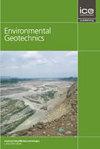A simplified methodology for determining the thermal performance of thermo-active piles
IF 2.2
4区 工程技术
Q3 ENGINEERING, GEOLOGICAL
引用次数: 0
Abstract
Ground source energy systems provide low carbon dioxide heating and cooling to buildings, but their efficient deployment requires a reliable estimate of their thermal performance. A simplified methodology is presented to determine the thermal performance of thermo-active piles when heating or cooling loads are specified with either inlet pipe temperatures or imposed heat fluxes. The proposed methodology avoids computationally expensive three-dimensional (3D) analyses and the explicit simulation of heat exchanger pipes, relying instead on two-dimensional thermal analyses. When the heating or cooling of a thermo-active pile is assessed by imposing inlet pipe temperatures, the proposed methodology allows the determination of the power of the pile per unit length. Conversely, when heating or cooling loads are specified through extracted or injected heat fluxes, the inlet and outlet fluid temperatures, as well as average temperatures at the pile wall, are determined. The proposed methodology has been shown to reproduce accurately the thermal performance of thermo-active piles modelled using 3D analyses where heat exchanger pipes are explicitly simulated, considering different patterns of heating and cooling cycles. The application of the proposed methodology to the case of a real thermo-active pile is demonstrated by comparing its predicted thermal performance with the results of a well-documented field thermal response test.确定热源桩热性能的简化方法
地源能源系统为建筑物提供低二氧化碳的加热和冷却,但它们的有效部署需要对其热性能进行可靠的估计。提出了一种简化的方法来确定热工桩的热性能,当加热或冷却负荷指定为进水管温度或施加的热通量时。提出的方法避免了计算昂贵的三维(3D)分析和换热器管道的显式模拟,而是依赖于二维热分析。当通过施加入口管道温度来评估热活性桩的加热或冷却时,建议的方法允许确定每单位长度的桩的功率。相反,当通过提取或注入热通量指定加热或冷却负荷时,则确定了入口和出口流体温度以及桩壁的平均温度。所提出的方法已被证明可以准确地再现热活动桩的热性能,使用3D分析建模,其中热交换器管道被明确地模拟,考虑到不同的加热和冷却循环模式。通过将预测的热性能与现场热响应测试结果进行比较,证明了所提出的方法在实际热活性桩案例中的应用。
本文章由计算机程序翻译,如有差异,请以英文原文为准。
求助全文
约1分钟内获得全文
求助全文
来源期刊

Environmental geotechnics
Environmental Science-Water Science and Technology
CiteScore
6.20
自引率
18.20%
发文量
53
期刊介绍:
In 21st century living, engineers and researchers need to deal with growing problems related to climate change, oil and water storage, handling, storage and disposal of toxic and hazardous wastes, remediation of contaminated sites, sustainable development and energy derived from the ground.
Environmental Geotechnics aims to disseminate knowledge and provides a fresh perspective regarding the basic concepts, theory, techniques and field applicability of innovative testing and analysis methodologies and engineering practices in geoenvironmental engineering.
The journal''s Editor in Chief is a Member of the Committee on Publication Ethics.
All relevant papers are carefully considered, vetted by a distinguished team of international experts and rapidly published. Full research papers, short communications and comprehensive review articles are published under the following broad subject categories:
geochemistry and geohydrology,
soil and rock physics, biological processes in soil, soil-atmosphere interaction,
electrical, electromagnetic and thermal characteristics of porous media,
waste management, utilization of wastes, multiphase science, landslide wasting,
soil and water conservation,
sensor development and applications,
the impact of climatic changes on geoenvironmental, geothermal/ground-source energy, carbon sequestration, oil and gas extraction techniques,
uncertainty, reliability and risk, monitoring and forensic geotechnics.
 求助内容:
求助内容: 应助结果提醒方式:
应助结果提醒方式:


